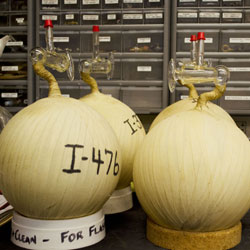In 2024, the yearly average level of the greenhouse gas carbon dioxide (CO2) rose faster over the prior year than ever before in the 67-year-old Keeling Curve record. When researchers took the average readings for all 12 months in 2024, the average was 3.58 parts per million (ppm) higher than for 2023’s average. That broke the record for largest jump … Read More
Record Annual Increase of Carbon Dioxide Observed for 2015
CO2 levels increasing at a faster rate than before
Is This the Last Year Below 400?
Leader of Keeling Curve measurement says temporary bump from El Niño could push atmospheric CO2 levels above symbolic threshold for good
American Chemical Society to Honor Keeling Curve in June 12 Ceremony
Scripps Oceanography lab monitoring atmospheric CO2 named National Historic Chemical Landmark
What Does This Number Mean?
Repost of April 2013 entry The Mauna Loa carbon dioxide (CO2) record, also known as the “Keeling Curve,” is the world’s longest unbroken record of atmospheric carbon dioxide concentrations.
A Keeling Curve Funding Update – April 2015
The Scripps Institution of Oceanography, UC San Diego O2 and CO2 programs have received funding from multiple sources that put these operations on a relatively secure footing for the next few years.
Is the Rate of CO2 Growth Slowing or Speeding Up?
The rate of growth in carbon dioxide concentrations in the atmosphere has accelerated since the beginnings of the Keeling Curve.
Wendy and Eric Schmidt Award $500,000 Grant to Keeling Curve
Supports continued operation of the iconic measurement series
As Told by the American Museum of Natural History…
The story of the Keeling Curve is beautifully animated in this new video. The American Museum of Natural History will host a Google+ Hangout Sept. 9, 2014 on the topic of the Keeling Curve. [youtube https://www.youtube.com/watch?v=0Z8g-smE2sk&w=560&h=315]
How are CO2 Data Processed?
Scientists make CO2 measurements in remote locations to obtain air that is representative of a large volume of Earth’s atmosphere and relatively free from local influences that could skew readings.




